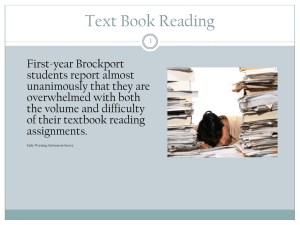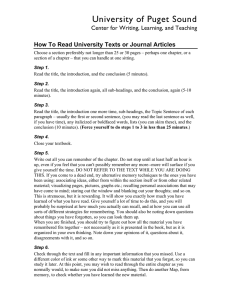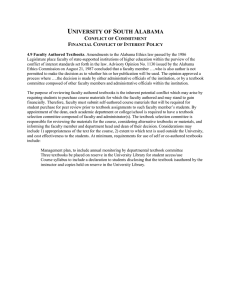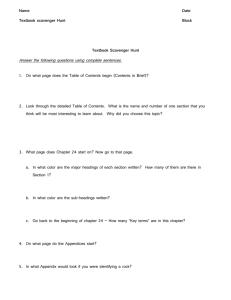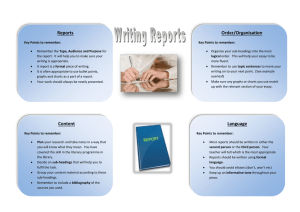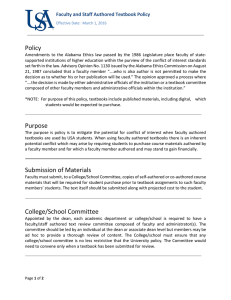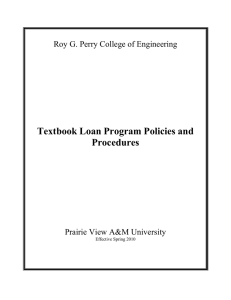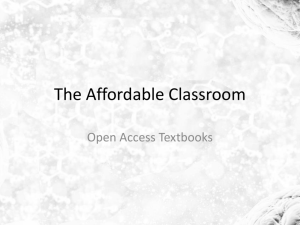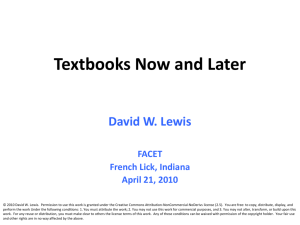Cornell Note Taking: Efficient Study for Academic Success
advertisement
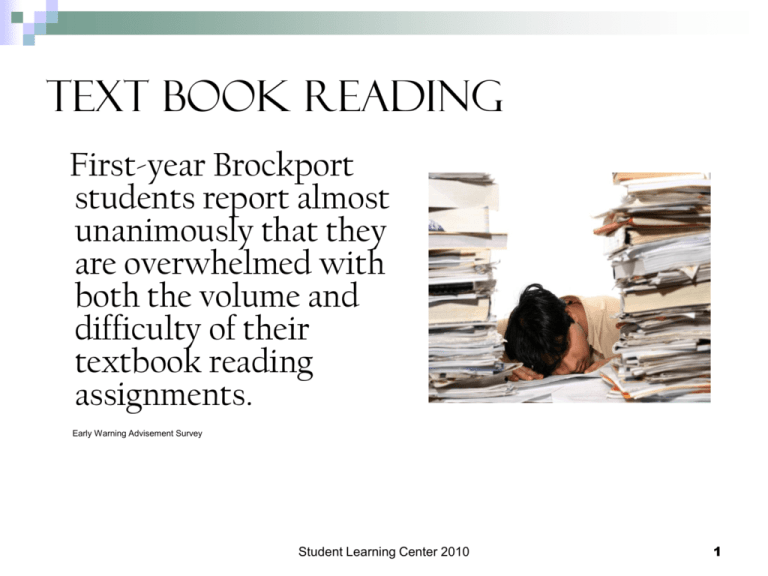
Text Book Reading First-year Brockport students report almost unanimously that they are overwhelmed with both the volume and difficulty of their textbook reading assignments. Early Warning Advisement Survey Student Learning Center 2010 1 Text Book Reading • Read but do not recall • Read part of assigned work • Don’t read at all Student Learning Center 2010 2 Text Book Reading Why don’t students read? No quizzes on the reading. Professor never talks about the reading assignment. Assignments too long. Student Learning Center 2010 3 Text Book Reading Why should students read? Supplement class lecture and notes. Prepare for class note-taking and listening. Build on previous knowledge. Read to learn, write to learn, talk to learn. A positive correlation between reading and overall success in class Student Learning Center 2010 4 Text Book Reading Grade Level of Accomplishment Quality Points A Highest Level of Work 4.00 A- 3.67 B+ 3.33 B Better than Average Work 3.00 B- 2.67 C+ 2.33 C Average Work 2.00 C- 1.67 D+ 1.33 D 1.00 D- Minimum Level of Passing Work 0.67 E Failing Work 0.00 Student Learning Center 2010 5 Text Book Reading Semester Honors Dean’s List = 3.40-3.69 Dean’s with Honors = 3.70-3.99 President’s List = 4.0 Student Learning Center 2010 6 Text Book Reading Goals for Reading Identify the most important points quickly Distinguish between main ideas and details Comprehend information quickly Sort and situate information into memory Review for exams efficiently Student Learning Center 2010 7 Text Book Reading Take out a textbook. Student Learning Center 2010 8 Text Book Reading So Many Textbooks. . . • Natural sciences • Foreign languages • Math • Literature • History • Primary sources Student Learning Center 2010 9 Text Book Reading Survey the Text as a Whole • title, author, date • preface, introduction, purpose, thesis, approach • table of contents, topics, subtopics, organization • chapter highlights, summaries, study questions, appendices Student Learning Center 2010 10 Text Book Reading Survey an Individual Assignment • Title • Introduction • Sub-headings • Topic sentences • Visual aids • Chapter summary, discussion questions, etc. Student Learning Center 2010 11 Text Book Reading Sample a paragraph to assess the following: • Your Interest & concentration span • The rate at which facts are presented • The difficulty of the text Student Learning Center 2010 12 Text Book Reading Schedule Reading Time & Place Break the reading assignment into small, manageable chunks of text. Schedule reading time for each chunk. Identify reading location. Student Learning Center 2010 13 Text Book Reading Questions What do you already know about this topic? What information do you hope to learn? What do you think the author might say? Student Learning Center 2010 14 Text Book Reading Form Questions Turn each of the main points found in the introduction, sub-headings, topic sentences, or summary into a question. Use these questions to guide your reading. Student Learning Center 2010 15 Text Book Reading Read Read the assignment you have surveyed, using your questions as a guide. Student Learning Center 2010 16 Text Book Reading Take Notes & Talk • Restate the main points and supporting details in you own words while you read. • Mark the text to indicate main points, definitions, characteristics, examples, and conclusions. • Use numbers to indicate important series of information. Student Learning Center 2010 17 Text Book Reading Review Notes & Check Knowledge • Review your notes, outline, or marked portions of the text • Test your comprehension. Student Learning Center 2010 18 Text Book Reading Summary • Note the differences in textbooks from discipline to discipline. • Preview assignment. • Schedule reading time. • Form questions. • Write and talk to improve comprehension • Test your understanding of information Student Learning Center 2010 19
